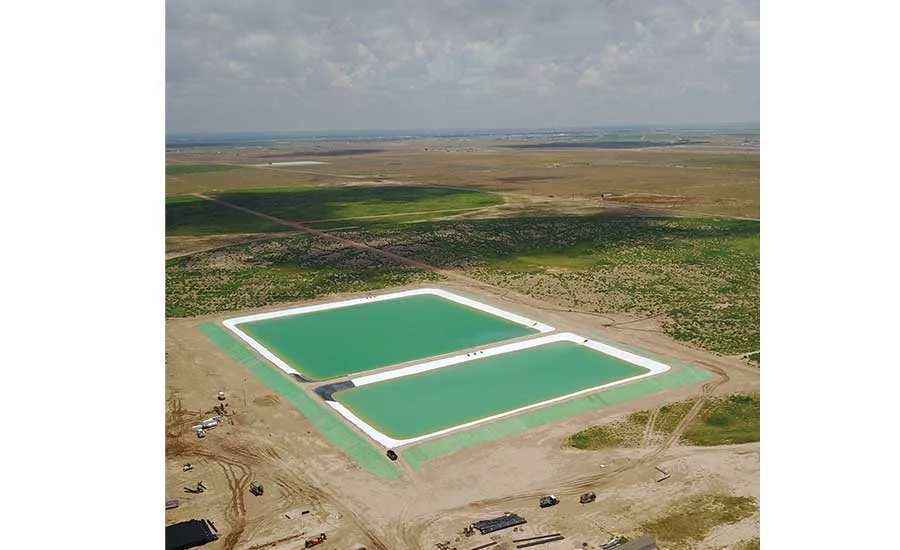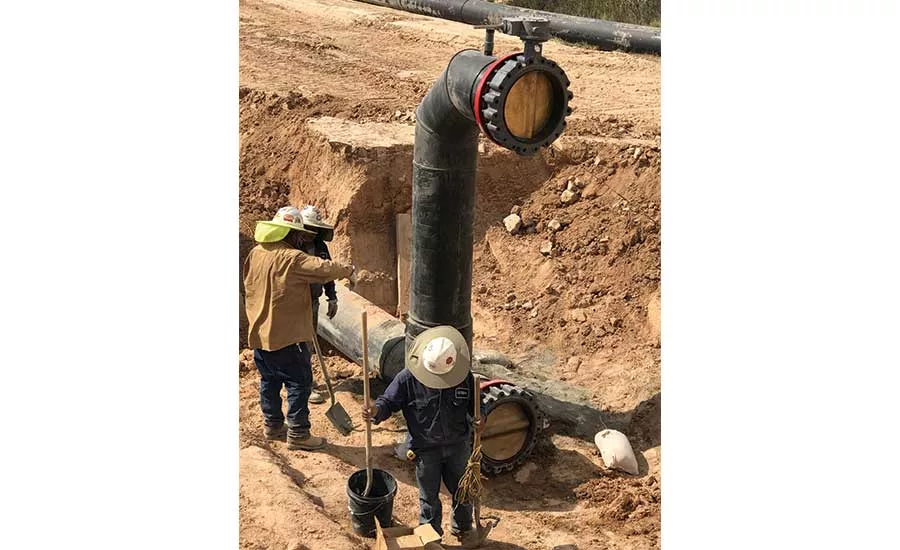Well Driller Finds Profitability in Oil, Gas Water Supply

Crews install a pump station suction header with risers to monitor in-ground storage pond levels. Source: LAN

Layne acquired 1,000 acres of water-producing land in the Pecos, Texas, area to feed 20 miles of high-capacity water pipeline used for hydraulic fracturing in the Delaware Basin. Source: Patriot Environmental

The property includes six high-capacity water wells, one pump station and two in-ground storage ponds. Source: LAN photo

The property includes six high-capacity water wells, one pump station and two in-ground storage ponds. Source: LAN photo
As a general rule of thumb, water well drilling jobs have a set timeline — they may take a day, they may take months, but not forever. And, almost always, the client owns the well and the property it resides on — they may be a homeowner, they may be a municipality, but the product is theirs to keep. Layne Christensen Company, one of the largest water well drilling companies in the country, is turning these two traditions on their heads.
“This is more of a midstream approach where we believe we can provide value to multiple customers by basically sharing cost across a broader range, and deliver water instead of delivering a well.”
– Byron Bevers
In light of rising demand for water in fracking operations, the company is growing from a well producer to a water supplier. Layne expects water usage within the energy sector to more than double over the next two years, especially in the Delaware Basin. Its new energy infrastructure business seizes the opportunity to provide oil and gas clients in West Texas with the millions of gallons of water per day they need. The innovative endeavor makes Layne the driller of its own wells, and there is no moving on; the company’s involvement is ongoing.
“This is a different business model from kind of the service aspect … where it’s, ‘Come drill a well and move on, and we’ll call you back if we need another well,’ ” says Byron Bevers, business development engineer with Layne. “This is more of a midstream approach where we believe we can provide value to multiple customers by basically sharing cost across a broader range, and deliver water instead of delivering a well.”
The water well drilling enterprise created an $18 million water system pulling from 1,000 acres of company-owned land in Pecos, Texas. The property includes six high-capacity water wells, one pump station and two in-ground storage ponds. It is the starting point of a 20-mile-long pipeline that extends northward, toward Orla, Texas. The pipeline — 22 inches in diameter — delivers up to 100,000 barrels of non-potable water per day to what Layne considers one of the most active oil and gas drilling areas in the U.S.
Many Moving Parts
The water-producing property in Pecos came equipped with four irrigation wells drilled in the ’50s. Two-man drilling crews from Layne worked days, pulling the turbines out of them and running cameras downhole to assess well integrity. They found deteriorated casing in one, so they kept three, rehabilitating them and installing lineshaft pumps. An Atlas Copco T3 drilling rig, equipped with dual-tube reverse, was used and rehab was completed in two weeks, starting March 28 and ending April 15. Layne pumps the refurbished wells at 800-900 gpm.
Layne crews also drilled three new 550-foot-deep water wells, each 26 inches in diameter with 16-inch casing. Two three-member crews used the flooded reverse circulation drilling method with a GEFCO JED B drilling rig. They worked around the clock, starting May 25 and finishing June 19. The new water wells are located within a mile of each other, and each produce 1,200 gpm.
“The wells discharge into what we call the well-gathering pipe network. They end up going into above-ground storage pits,” Bevers says. “One is 500,000 barrels and one is 250,000 barrels. The wells basically discharge into those pits. Then we have another pump station on the other side of the pits that takes the water from the pits and puts it into the pipeline.”
The drilling jobsite, located in an arid climate, was “flat, dusty and it was hot,” says Cody Myers, general manager of Layne’s Midland, Texas, drilling office. Aside from 100-degree days, the rural jobsite wasn’t especially challenging. The land was flat and the sound barriers crews contend with in more populated areas were non-existent. There was also plenty of space to store equipment. Crews drilled into an alluvium formation consisting of clay, sand and gravel, and had no notable troubles with penetration.
While Layne handled all water well-related work in-house, third-party contractors installed the pump stations, storage pits and pipeline. Since each aspect of the project was handled simultaneously, Layne contracted engineering firm Lockwood, Andrews & Newnam Inc. (LAN) to oversee design and construction. “It was a 90-day construction schedule for 107,000 linear feet [of pipeline], so it was extremely aggressive. Everybody had to be communicating daily to keep this thing moving forward. Coordination during construction was definitely a big effort,” says Alex Kajdan, LAN project engineer.
The overall water system project is up and running. Construction of the storage pits started March 1 and pipeline construction began May 1. Layne was contracted to deliver water by Aug. 1 and ended up delivering water June 15.
Midstream Solution
Contractors installed an electronic automation system to remotely monitor and control things like storage levels, pipeline pressures, volume deliveries and well production. Transducer data connects with Layne’s SCADA program. In addition, well pump motors are equipped with variable frequency drives (VFDs) to allow operational flexibility. The underground network of pipelines ties all six water wells together so Layne can control which wells it pulls water from and which storage pits the water feeds. “So we’ve really got a lot of flexibility,” Bevers says.
As with any effective business model, Layne’s diversification into water supply solves real problems. For one, Bevers points out that the conventional way to provide water for oil and gas operators is by truck. He estimates that oil and gas customers need high volumes of water — around 500,000 barrels — in compressed timeframes like 10 days. As that demand for water creeps up, truck delivery grows less practical. Not only are trucks more time-consuming supply options, they create safety hazards and contribute to road deterioration. Pipelines are a more efficient alternative.
Bevers also points out the non-potable factor. “This is water that isn’t able to be used for potable sources and really not able to be used for most agriculture reasons either. So we’re taking water that essentially can’t be used for other purposes and we’re delivering it to oil and gas operators in a high-capacity rate so they can proceed with hydraulic fracturing. … Some people have sourced water from potable sources, so we’re able to leave the potable sources for other uses where those might be appropriate.”
Source of Constant Cash Flow
Financial returns from the system were anticipated during Layne’s fiscal third quarter. Earnings are back-stopped through an initial four-year contract containing minimum volume purchases from a publicly-traded, independent oil and gas producer that is actively drilling in the area. Most pipeline customers are expected to discharge water received into above-ground storage pits. Water use is metered and Layne is paid based on how much they consume.
While the initial contract is expected to ensure adequate cash flow, the company plans to expand. The pipeline has the capacity to support additional water sources and delivery points. It features 13 riser stations that customers can connect to. “Our pipeline goes through kind of the heart of the Delaware Basin and we pass several oil and gas operators that we hope to be customers,” Bevers says. “It’s a matter of just opening a valve and we can deliver water to a customer.”
The long-term plan is two-phased. First are sales, selling as much water as possible to oil and gas operators. Second is the technical side, committing to responsible use of the resource. “One of the things we’re going to be monitoring is that we are developing this water resource responsibly. If we need to adjust how we are pumping the water or if we need to add additional wells or even if we need to stop using a well, we’re committing to doing that,” Bevers says.
Layne is pleased with its first-ever midstream water supply project and thinks there are additional places this solution would make sense. The good news is that even in cases that don’t call for an all-out pipeline project, Layne’s 135 years of traditional water well drilling experience are still relevant.
Looking for a reprint of this article?
From high-res PDFs to custom plaques, order your copy today!



